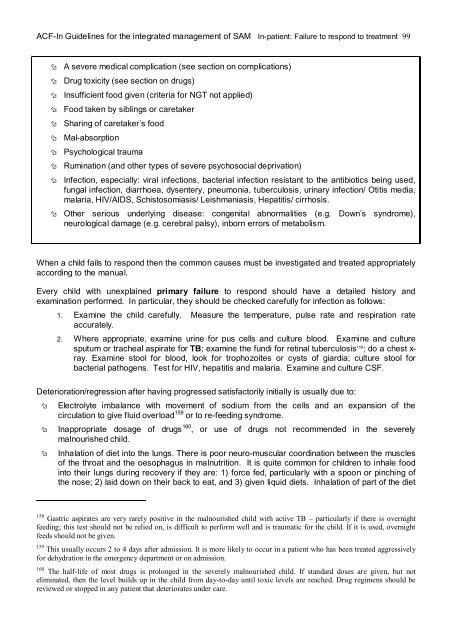guidelines for the integrated management of severe acute malnutrition
guidelines for the integrated management of severe acute malnutrition
guidelines for the integrated management of severe acute malnutrition
Create successful ePaper yourself
Turn your PDF publications into a flip-book with our unique Google optimized e-Paper software.
ACF-In Guidelines <strong>for</strong> <strong>the</strong> <strong>integrated</strong> <strong>management</strong> <strong>of</strong> SAM In-patient: Failure to respond to treatment 99<br />
� A <strong>severe</strong> medical complication (see section on complications)<br />
� Drug toxicity (see section on drugs)<br />
� Insufficient food given (criteria <strong>for</strong> NGT not applied)<br />
� Food taken by siblings or caretaker<br />
� Sharing <strong>of</strong> caretaker’s food<br />
� Mal-absorption<br />
� Psychological trauma<br />
� Rumination (and o<strong>the</strong>r types <strong>of</strong> <strong>severe</strong> psychosocial deprivation)<br />
� Infection, especially: viral infections, bacterial infection resistant to <strong>the</strong> antibiotics being used,<br />
fungal infection, diarrhoea, dysentery, pneumonia, tuberculosis, urinary infection/ Otitis media,<br />
malaria, HIV/AIDS, Schistosomiasis/ Leishmaniasis, Hepatitis/ cirrhosis.<br />
� O<strong>the</strong>r serious underlying disease: congenital abnormalities (e.g. Down’s syndrome),<br />
neurological damage (e.g. cerebral palsy), inborn errors <strong>of</strong> metabolism.<br />
When a child fails to respond <strong>the</strong>n <strong>the</strong> common causes must be investigated and treated appropriately<br />
according to <strong>the</strong> manual.<br />
Every child with unexplained primary failure to respond should have a detailed history and<br />
examination per<strong>for</strong>med. In particular, <strong>the</strong>y should be checked carefully <strong>for</strong> infection as follows:<br />
1. Examine <strong>the</strong> child carefully. Measure <strong>the</strong> temperature, pulse rate and respiration rate<br />
accurately.<br />
2. Where appropriate, examine urine <strong>for</strong> pus cells and culture blood. Examine and culture<br />
sputum or tracheal aspirate <strong>for</strong> TB; examine <strong>the</strong> fundi <strong>for</strong> retinal tuberculosis 158 ; do a chest xray.<br />
Examine stool <strong>for</strong> blood, look <strong>for</strong> trophozoites or cysts <strong>of</strong> giardia; culture stool <strong>for</strong><br />
bacterial pathogens. Test <strong>for</strong> HIV, hepatitis and malaria. Examine and culture CSF.<br />
Deterioration/regression after having progressed satisfactorily initially is usually due to:<br />
� Electrolyte imbalance with movement <strong>of</strong> sodium from <strong>the</strong> cells and an expansion <strong>of</strong> <strong>the</strong><br />
circulation to give fluid overload 159 or to re-feeding syndrome.<br />
� Inappropriate dosage <strong>of</strong> drugs 160 , or use <strong>of</strong> drugs not recommended in <strong>the</strong> <strong>severe</strong>ly<br />
malnourished child.<br />
� Inhalation <strong>of</strong> diet into <strong>the</strong> lungs. There is poor neuro-muscular coordination between <strong>the</strong> muscles<br />
<strong>of</strong> <strong>the</strong> throat and <strong>the</strong> oesophagus in <strong>malnutrition</strong>. It is quite common <strong>for</strong> children to inhale food<br />
into <strong>the</strong>ir lungs during recovery if <strong>the</strong>y are: 1) <strong>for</strong>ce fed, particularly with a spoon or pinching <strong>of</strong><br />
<strong>the</strong> nose; 2) laid down on <strong>the</strong>ir back to eat, and 3) given liquid diets. Inhalation <strong>of</strong> part <strong>of</strong> <strong>the</strong> diet<br />
158 Gastric aspirates are very rarely positive in <strong>the</strong> malnourished child with active TB – particularly if <strong>the</strong>re is overnight<br />
feeding; this test should not be relied on, is difficult to per<strong>for</strong>m well and is traumatic <strong>for</strong> <strong>the</strong> child. If it is used, overnight<br />
feeds should not be given.<br />
159 This usually occurs 2 to 4 days after admission. It is more likely to occur in a patient who has been treated aggressively<br />
<strong>for</strong> dehydration in <strong>the</strong> emergency department or on admission.<br />
160 The half-life <strong>of</strong> most drugs is prolonged in <strong>the</strong> <strong>severe</strong>ly malnourished child. If standard doses are given, but not<br />
eliminated, <strong>the</strong>n <strong>the</strong> level builds up in <strong>the</strong> child from day-to-day until toxic levels are reached. Drug regimens should be<br />
reviewed or stopped in any patient that deteriorates under care.

















